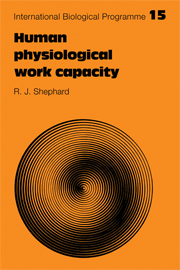Book contents
- Frontmatter
- Contents
- Foreword
- Preface
- 1 Introduction
- 2 Sampling and population studies
- 3 Methods for the measurement of physical fitness, working capacity and activity patterns
- 4 Climate, season and local geography
- 5 Socio-economic status and working capacity
- 6 Working capacity and constitution
- 7 The physical working capacity of the athlete
- 8 The growth of working capacity
- 9 Age and working capacity
- 10 Epilogue
- IBP Human Adaptability section publications
- References
- Index
2 - Sampling and population studies
Published online by Cambridge University Press: 20 May 2010
- Frontmatter
- Contents
- Foreword
- Preface
- 1 Introduction
- 2 Sampling and population studies
- 3 Methods for the measurement of physical fitness, working capacity and activity patterns
- 4 Climate, season and local geography
- 5 Socio-economic status and working capacity
- 6 Working capacity and constitution
- 7 The physical working capacity of the athlete
- 8 The growth of working capacity
- 9 Age and working capacity
- 10 Epilogue
- IBP Human Adaptability section publications
- References
- Index
Summary
Physiologists sometimes devote considerable effort to the elaboration of precise methodology (Chapter 3). However, too little care is directed to the influence of population sampling upon the generality of the results thus obtained (Rose & Blackburn, 1968; Shephard & Andersen, 1971).
Sampling and the human adaptability project
In early discussion of the IBP project (Weiner, 1964), it was recognized there would be sampling problems when studying the populations of industrialized nations; thus in the context of physical fitness and working capacity, investigators were asked to record age, sex, physique, fitness, occupation, health status, and degree of urbanization. On the other hand, with respect to primitive communities, it was assumed that ‘the relatively small size of these populations [would] render them more manageable’. Nevertheless, observers were asked to make a careful identification of the group studied in terms of linguistics, religious affiliation, nationality, ethnology, socio-cultural background (hunting, food-gathering, nomadic, pastoral, horticultural, simple agricultural, advanced agricultural, rural, urban, or industrial) and socio-economic status (in terms of accepted occupational and social indices). Investigators were also requested to state whether they thought the subjects tested were representative of the population under study; specific comment was to be made on sampling methods and any inhomogeneity within samples. Unfortunately, these instructions have been largely ignored, and in many instances information about sample composition is extremely limited.
Sample size
At the outset of the IBP project, it was assumed that application of normal-distribution statistics to relatively large samples would resolve many problems (Weiner, 1964; Weiner & Lourie, 1969).
Information
- Type
- Chapter
- Information
- Human Physiological Work Capacity , pp. 9 - 21Publisher: Cambridge University PressPrint publication year: 1978
